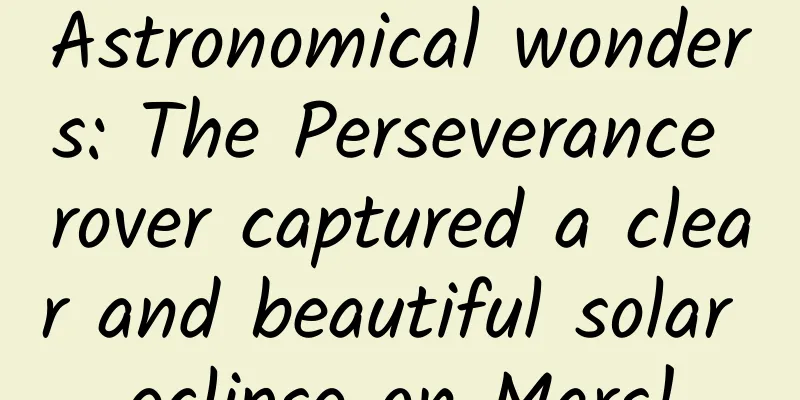Astronomical wonders: The Perseverance rover captured a clear and beautiful solar eclipse on Mars!

|
A solar eclipse on Earth is caused by the Earth's only natural satellite, the Moon, being sandwiched between the Sun and the line of sight of humans on Earth, blocking part or all of the Sun, making it look like a shadow is cast on the surface of the Sun; a solar eclipse on Mars is of course caused by the Martian satellite blocking the Sun and the line of sight of Mars, casting a shadow on the surface of the Sun. Mars has two natural satellites, Phobos and Deimos. Phobos is called Phobos in English. It is about 9,378 kilometers away from the core of Mars on average. Excluding the radius of Mars, it is only about 6,000 kilometers away from the surface of Mars. Phobos is about 13.5*10.8*9.4 (km) in size and has a mass of about 1.38*10^14 kg. Phobos' English name is Deimos. It is about 23,459 kilometers away from the core of Mars on average. It is about 15*12*11 (kilometers) in size and has a mass of about 1.8*10^15 kilograms. It is the smallest satellite in the solar system. Because of their small mass, these two satellites cannot achieve the hydrostatic equilibrium, that is, the spherical state, by their own gravity to overcome their own solid rigid body force, and therefore appear to be in an irregular potato shape. These two satellites revolve around Mars. Phobos has an orbital period of 7 hours and 59 minutes, while Mars has a rotation period of 24 hours, 37 minutes and 22.7 seconds, which is similar to the Earth. So Phobos revolves around Mars about three times a day; Deimos has an orbital period of 30 hours and 18 minutes, which means it revolves around Mars once in a little over a day. Although there are no traces of humans on Mars, there are also "sights", which are the various probes sent to Mars by humans, including 6 Mars rovers. Among these 6 Mars rovers, 5 were sent by NASA, and one was sent by China, called "Zhurong". The photo of the Martian solar eclipse was taken by the Perseverance rover sent by NASA. The rover was launched from Cape Canaveral Air Force Station in Florida, U.S., on July 30, 2020, and arrived on Mars on February 19, 2021. It landed in the Jezero Crater on Mars through a stunning "air crane" method. This clear image of the solar eclipse on Mars was taken and transmitted back by Perseverance's new generation Mastcam-Z camera on April 2, US time, when Phobos was sandwiched between Perseverance's "line of sight" and the sun. The image lasted for more than 40 seconds in total. This day is the 397th Martian day after Perseverance landed on Mars. Prior to this, Perseverance also sent back many wonderful photos of the Martian terrain. |
>>: The tooth fairy never forgets the pain in your heart
Recommend
Emotional Worry-solving Society - Love Guide
Emotional Worry-Resolving Society - Love Guide Res...
The Hangzhou Asian Games flame was successfully collected. You need to know the principle of fire collection using a concave mirror...
On June 15, the flame of the Hangzhou Asian Games...
App Store September review rejection reasons ranking! Apple's review focus turns out to be these...
As an App promoter , one of the most painful thin...
14 problems and solutions for bidding promotion!
In bidding promotion , we often encounter some co...
100 light years away, a "perfect solar system" was discovered
Author: Duan Yuechu Your browser does not support...
Tree seeds have "wings"? But they can only spread farther after the wings are removed!
In nature, plants adopt various strategies to rep...
How to create a hit product through online operation and promotion?
When it comes to hot-selling products, I believe ...
Dutch scientists propose opening a robot red-light district by 2050
In the setting of "Ghost in the Shell",...
A perfect event planning plan cannot be without these elements!
Do you hope that the event will become a hit? Tha...
GeForce Experience adds four new features, driver upgrade "significant" changes
NVIDIA's GeForce Experience (GFE) is a very g...
“Three small screens” divert the number of people watching TV
With the development of the Internet and intellig...
This bird is ugly and bald, but more than 10,000 women are protecting it
This bird is "ugly" and bald, but more ...
Today in Science and Technology History | 1609·8·21 The first astronomical telescope was born
Since ancient times, human beings have never stop...
Medium video project operation tutorial: earn 150+ in one week of operation, and the income will grow bigger and bigger as the number increases.
Medium video project operation tutorial: earn 150...
Beware! Bacteria "Killers" in the Refrigerator
In the long history of biological evolution We hu...









